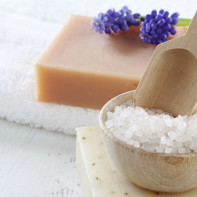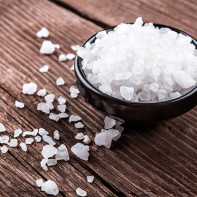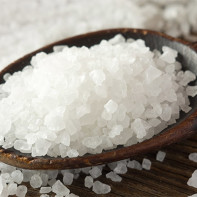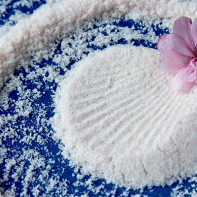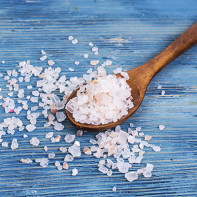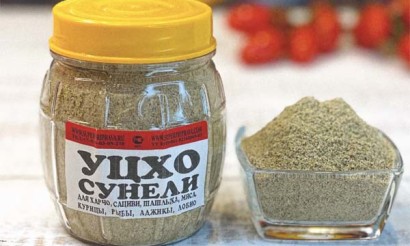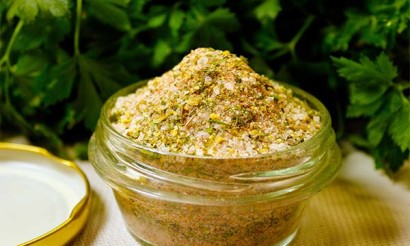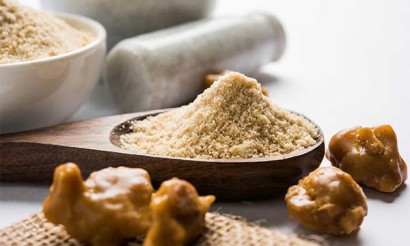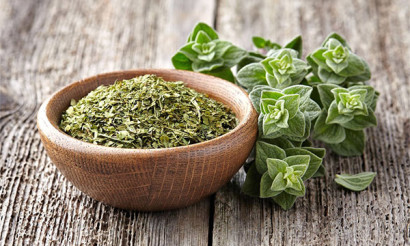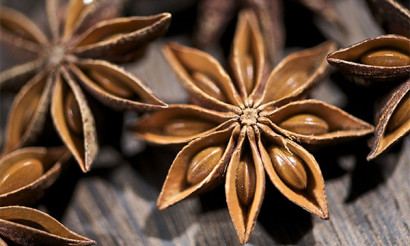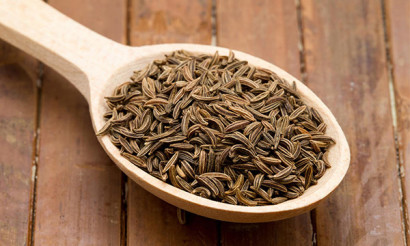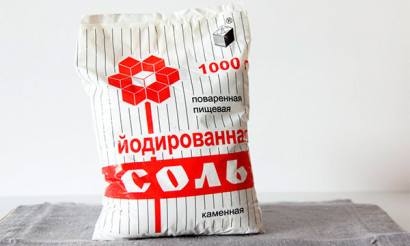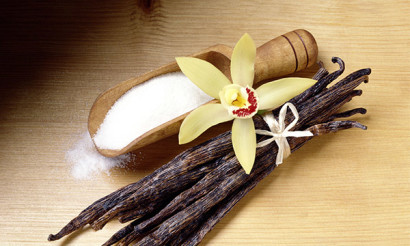Food sea salt: useful properties and contraindications
For more than a thousand years, people have used sea salt in various spheres of life. In some periods of history it was even used as currency. In addition, famous philosophers and sages believed that it has exceptional therapeutic properties, since it was believed that the origin of life took place in natural bodies of water, and salt played an important role in this process.
- Sea Salt Types
- What is the difference between sea salt and table salt?
- Which salt is healthier: sea or table salt?
- Composition and Calories
- How much sea salt is useful
- General benefits
- For Women
- For Men
- For Pregnancy
- For children
- Slimming
- Sea Salt Bathing: Benefits and Harms
- How to take a bath
- Sea Salt in Medicine
- Diabetes
- For Intestines
- For Constipation
- For gout
- For osteoarthritis
- For hemorrhoids
- For teeth
- Eczema
- Guillotine
- How to Dilute Sea Salt for Nose Bathing
- Sea Salt in Cosmetology
- For Face
- For hair
- For the Body
- Sea Salt in Cooking
- Can I salt lard and fish with sea salt?
- Harm and contraindications
- How to choose and store sea salt
- Interesting Facts about Sea Salt
Sea salt has a gray hue because it contains many minerals. Salt lakes and inland seas are rich sources of it. Natural processes occurring in these areas contribute to the natural evaporation of water, which leaves salt deposits on the surface. At the moment, some experts confirm the Platonic theory, arguing their position with the fact that human blood contains a commensurate amount of salt with its concentration in the natural fluid.
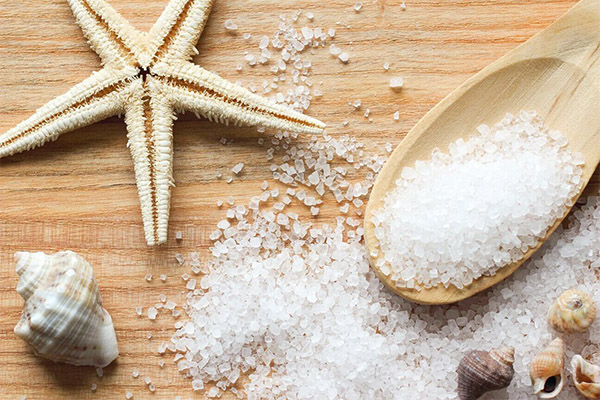
Types of sea salt
- Himalayan. The place of extraction is Pakistan. This salt is one of the highest quality products, compared to other types it is more pure. It has a very rich mineral composition, has a beautiful light pink hue.
- Macedonian. The place of extraction is England. The salt is obtained by the "evaporation" method. The product has a white color and bright taste.
- Hawaiian Black. The place of extraction is Hawaii. The salt has a black color because it contains particles of lava, which give it a large number of additional useful substances.
- Hawaiian Red. The place of extraction is Hawaii. The salt is red in color because it contains red clay, which gives the product its spiciness and unusual color.
- Persian Blue. The place of extraction is northern Iran. The salt is blue in color because it contains the mineral sylphinite. It is considered one of the rarest salts and has a strongly pronounced taste.
The difference between sea salt and table salt
Table salt is a rather dirty product, which is gray in color and contains various impurities. The place of extraction of table salt is mines, so it is not possible to rid it of all organic impurities. Such salt contains various impurities (about 0.5%) that are dangerous to the human body. One type of this kind of salt is extra. It is refined salt, that is, a purified product that contains 99% sodium chloride. Extra salt is processed by washing it and purifying it from various impurities through high temperatures, adding chemicals. These manipulations give the product a snow-white color, make the salt more crumbly and prevent it from sticking to lumps.
Sea salt is a product crystallized by natural processes. It is rich in iodine, calcium, magnesium, bromine, etc. These are valuable substances for humans, a sufficient amount of which allows to maintain normal functioning of the body. This product is not chemically processed, so it has no harmful additives. It has a pleasant aroma, richer and milder taste than table salt. You can note a significant difference between these types of salt. For example, if you put a living creature of the sea in the water with table salt, it will not survive in it, but if you use salt just sea, then in this water can live.
Which salt is healthier: sea salt or table salt?
Sea salt is considered more useful for several reasons:
- A completely natural product with no chemicals;
- natural, natural method of production;
- the absence of various impurities;
- the presence of a huge amount of minerals.
Therefore, people who care about their health, it is recommended to use exactly sea salt.
Composition and calories
In 100 grams of the product contains:
- calories - 0 kcal;
- protein - 0.0 g;
- fats - 0,0 g;
- Carbohydrates - 0.0 g.
This product contains a large number of useful and important substances for the human body. It is rich in potassium, sodium, calcium, magnesium, iron, bromine, iodine and other trace elements.
How useful sea salt is
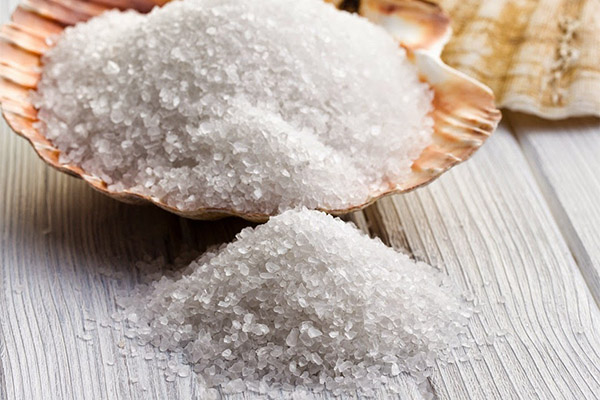
General benefits
- Relieves the pain of arthritis. Sea salt has been found to have anti-inflammatory properties that help relieve the pain caused by rheumatoid arthritis. Salt baths help relieve joint pain.
- Rejuvenates the skin. The coarse, grainy texture of sea salt makes it ideal for use as a skin rub. Gently rubbing the salt helps remove dead skin cells, improves circulation and promotes rejuvenation.
- Supports the acid-alkaline balance. Magnesium contained in different types of salts helps to maintain acid-alkaline balance in the body. It is recommended to consume sea salt regularly to reduce acidity in the blood.
- It strengthens the immune system. This product contains minerals - iron, phosphorus, zinc, manganese, magnesium, iodine and potassium, which help boost the immune system. In addition, the alkalizing effect of this product prevents the spread of bacteria and viruses, protecting the body from various infectious diseases.
- It improves heart health and normalizes heartbeat. Sea salt can improve cardiovascular function and regulate the heartbeat. It contains sodium, chloride and potassium, which support nerve impulse functionality and muscle contraction. This, in turn, helps maintain a regular heartbeat.
- Helps you lose weight. Sea salt regulates the secretion of digestive juices, which prevents excessive buildup in the digestive tract and thus helps to get rid of excess weight.
- It supports the work of the brain, muscles and nervous system. The body needs electrolytes such as sodium, chloride, and potassium to function properly. Sodium is especially important because it is involved in the transmission of nerve impulses. They allow the brain, muscle tissues, and nervous system to communicate with each other and perform various body functions.
- Fights depression. Some studies have shown that sea salt can help treat depression. Salt helps regulate two hormones in the body, serotonin and melatonin. These hormones directly affect the state of relaxation and sleep.
- It helps avoid dehydration. Sodium is responsible for water retention in the body, so its deficiency can cause the body to lose water quickly, resulting in dehydration. Daily consumption of sea salt provides enough sodium and also maintains the balance of sodium and potassium in the body, which is crucial for maintaining proper fluid balance at the cellular level.
- Useful for oral health. When it comes to dental health, sea salt is the best option. It contains fluoride, a mineral that promotes healthy teeth. It protects them from acidic damage, prevents demineralization of enamel and the development of tooth decay.
- It also prevents hair loss. Topical use of sea salt solutions can help increase circulation and improve blood flow to the bulbs. Scalp massages with a sea salt solution stimulate hair growth and strengthen hair follicles. Sea salt can also be used to treat scalp problems and dandruff. It will help loosen the exfoliation of dead skin by improving circulation and absorbing excess moisture. It will also help prevent the development and spread of fungi.
For Women
Sea salt is very beneficial for women's health because it helps prevent hair loss and promotes oxygen to the follicles of the scalp. Baths with sea salt are very useful in the period of weight loss, they help to prevent the formation of cellulite. With the help of salt you can get rid of acne and various rashes, as well as strengthen the nails.
For men
Sea salt is also useful for men's health. This product can support the body of men, especially those who bear regular heavy intensive physical activity. As a result of hard work, the body loses electrolytes along with sweat. To prevent electrolyte deficiency, you should regularly consume sea salt, which is rich in them. This will help prevent muscle cramps and alleviate the overall condition of the body.
Pregnancy
During pregnancy, some experts advise women to take salt baths, although this is quite ambiguous. On the one hand, sea salt is an excellent source of iodine, which is necessary for the body of the mother and her baby, on the other hand, there are contraindications that prohibit pregnant women to take hot salt baths. In any case, it is better not to take the risk, but to consult with a specialist.
For children
On the basis of sea salt, you can make remedies for the treatment of children. For example, salt baths will be very useful at home, and salt solutions can be used to wash the nose, gargle the throat and warm the body. That said, you should only begin procedures after consulting a pediatrician who knows the child well. Saline remedies are usually allowed after the child is 1 month old.
When losing weight
Sea salt is a product that can help you lose extra pounds. There are several ways to use this product to fight excess weight.
- If you need to perform a colon cleansing, but do not want to resort to various drugs with a laxative effect, you can try drinks with sea salt (preparation 1 tsp. per 1 liter of water). The cause of gaining excess weight may be disturbed digestion processes and irregular and too slow purging of the intestines. In such cases, saline solutions will help to accelerate weight loss and prevent constipation. The greatest effectiveness of the drinks can be demonstrated during a protein diet.
- For getting rid of cellulite and smoothing the skin you can do massages with salt. For example, you can make scrubs based on sea salt, which will help in the fight against cellulite. The scrubs smooth out the orange peel and smooth out the skin.
- To clean pores and remove toxins and excess fluid from the subcutaneous layers, sea salt baths are excellent. Such baths will rid the body of excess fluid, while contributing to increase skin turgor and prevent its stretching after weight loss.
Sea salt for the bath: benefits and harms
The benefits of sea salt for baths:
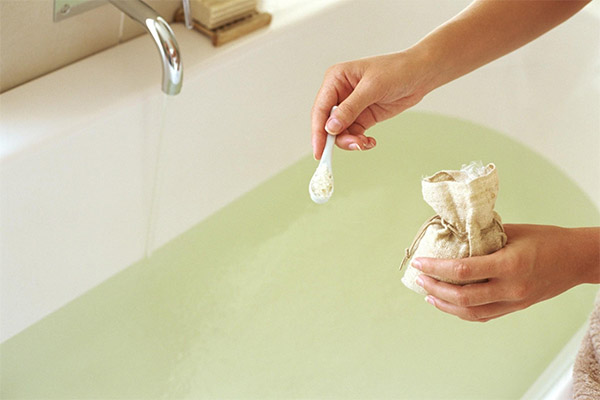
- Purification of the body. In the composition of sea salt there is sodium, which supports the removal of toxins and eliminates excess water from the body.
- Relaxing effect. Bromides, potassium and magnesium reduce the intensity and strength of pain. Warm salt water helps to relieve muscle cramps and relaxes the whole body.
- Reduces rheumatic pain. Sea salt is used to treat arthritis. It has properties that stimulate better blood circulation.
- Treatment of colds. A bath using sea salt is a great way to fight colds. It will help strengthen the immune system and contribute to a speedy recovery.
- Antibacterial properties. Sea salt can act as a disinfectant. Salt water heals small cuts and helps stop bleeding by speeding up blood coagulation.
Despite the large number of positive characteristics, salt baths are not suitable for everyone:
- The procedures should be abandoned in cases of acute inflammatory diseases, as well as in cases of low blood pressure.
- Salt baths are contraindicated for pregnant women, as well as in the presence of malignant tumors.
- Under no circumstances should such baths be taken by people who suffer from thrombosis or have insulin dependence.
How to take a bath properly
To extract the maximum benefit from the procedure of taking a salt bath, you need to follow some rules. Proportions: 200-500 grams per 100 liters of water. Baths can be taken even every day, but their number should be limited. During treatment the maximum number of procedures is about twenty, after which it is mandatory to organize a break for several months. Baths are recommended to take in the evening, as this procedure is quite relaxing, calming and soothing.
At the end of the procedure each time the body should be rinsed to rinse all the salt from the surface of the skin. After rinsing, it is highly recommended to rub the body with a stiff towel. After all the manipulations, you need to let the body rest, and after 30 minutes, lubricate it with moisturizing cream.
Sea Salt in Medicine
Sea salt is a very important product for the human body, both as a food additive and as a treatment. The rich mineral composition of this product supports the health of the body, so salt is widely used for both prevention and treatment of various diseases.
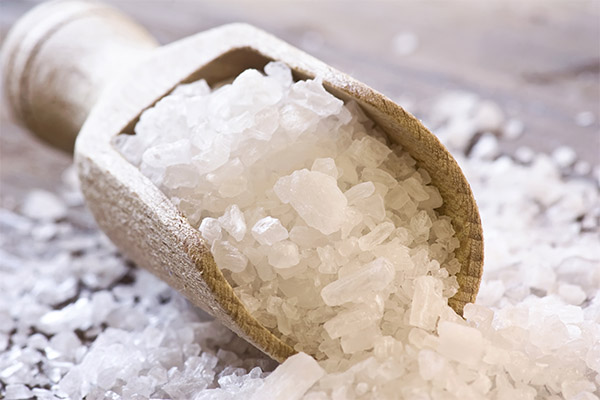
For diabetes
With diabetes, you can use salt, but the norm should be reduced by half. This will help slow the development of hypertension and diabetic nephropathy. Sea salt supports the genitourinary system, activates the metabolism, which is very important in diabetes, strengthens the immune system, eliminates muscle spasms and normalizes the level of glycemia. It is very important to observe the measure of consumption. Only a specialist can determine the total dosage of salt, but the approximate norm in cases of diabetes is up to 2.8 grams of sea salt per day.
Important: The glycemic index of sea salt is 0 units.
For the intestines
Salt is very useful for the intestines. It is recommended to take it together with water in the form of a salt drink. It will be useful to drink a glass of water with salt in the morning on an empty stomach in order to start the gastrointestinal tract and push out the remaining masses in it. This is quite an effective way to cleanse the intestines of toxins.
For constipation
In addition to a properly organized diet, sea salt can also help in the fight against constipation. It is not only able to have a laxative effect, but also helps to normalize the metabolism, stimulate the gastrointestinal tract and strengthen the body's defenses. Acceptance of sea salt leads to better digestion of food and timely emptying of the intestines.
Gout
Gout is caused by deposits of uric acid salts in the body. During attacks, the skin may become red and swollen, and there may be severe pain and fever. In this case, salt baths are very helpful. For preparing baths is recommended to use sea salt, as it has anti-inflammatory properties.
With osteoarthritis
Inflammation of the joints causes discomfort and pain. Drugs aimed at combating inflammation can provoke side effects. For this reason, people often turn to folk medicine. Treatment of arthritis with salt is the safest and most affordable option. Salt can be used as compresses, baths or do with its help rubbing. The most effective is considered to be sea salt, so it is highly recommended to use it.
When hemorrhoids
Sea salt is actively used to treat hemorrhoids. It helps to normalize microcirculation in the affected area, which leads to faster healing of the wounds and elimination of hemorrhoids. Sea salt has an irritating effect on the skin receptors, which leads to activation of blood circulation in the affected area. This increases the regenerative capacity of tissues. In addition, this product has an antimicrobial effect, getting rid of purulent inflammation. Salt can be used in the form of suppositories, compresses, baths, lotions, microclysters.
For the teeth
Sea salt has a positive effect on the teeth. It helps to strengthen the teeth, heal the gums and prevent decay. In addition, salt can whiten enamel and remove unpleasant taste. Saline solutions are used by people with sensitive gums. Salt is also an excellent analgesic and antiseptic, so in cases of toothache you can use a salt solution to rinse your mouth for pain relief.
For eczema.
Salt can also be used to treat eczema because it has a healing effect. The substances it contains penetrate through the skin pores, which leads to better healing of the affected areas and normalization of biochemical processes in the epithelial cells. Salt solutions have an antiseptic effect, strengthen the immune system.
For maxillary sinusitis
Sea salt has a rich mineral composition, so it helps to get rid of the symptoms of colds. Moreover, it can be used not only for colds, but also in cases of maxillary sinusitis. When the symptoms of maxillary sinusitis, accompanied by nasal congestion, you should rinse the sinuses with salt (1 tsp. dissolved in a mug of hot water). This will help neutralize bacteria and remove mucus. Salt has advantages over various drugs that can harm the body because it has no side effects.
How to dilute sea salt for nasal irrigation
To prepare a salt solution, dissolve purified sea salt (1 tbsp) in warm water (200-250 ml). In case there is a precipitate, the solution should be filtered with special paper. For children, the salt solution should be less concentrated.
Sea Salt in Cosmetology
Sea salt is quite widely used in modern cosmetology, because it helps to solve problems related to the skin of the face and body. There are many different lotions, scrubs, masks and creams that contain sea salt. It is worth noting that home-made remedies can be just as effective as expensive tubes and cans.
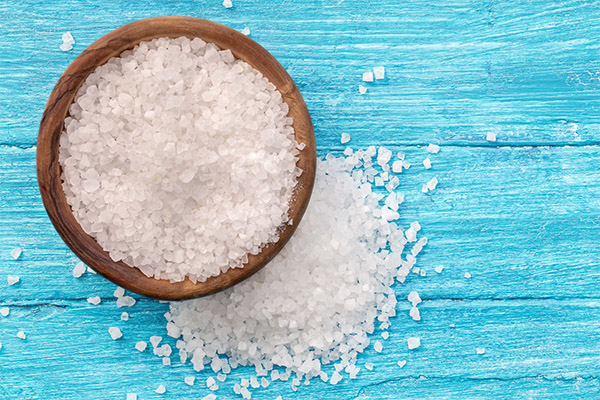
For the face
Nourishing mask for dry and normal skin:
- Mix sea salt (1 tbsp) with thick sour cream (2 tbsp) and olive oil (1 tbsp).
- Apply the mixture (massaging movements) on a cleaned and steamed face.
- Wait for 5 minutes.
- Wash out with cool water.
- Apply moisturizing cream to the face.
Mask for skin elasticity
- Melt floral honey (2 tbsp.) in a steam bath.
- Mix it with sea salt and lemon juice (1 tbsp.).
- Apply the mixture to face and neck.
- Wait 20 minutes.
- Wash out with warm water.
- Wipe your face with a pore-shrinking tonic.
For hair
Hair growth mask:
- Mashed potato 1 banana (medium size) into a puree and mix it with sea salt (1 tbsp).
- Mix well (in a blender) and rub the mixture into the scalp.
- Put a plastic bag on your head and wrap with a towel.
- Wait 30 minutes.
- Wash your hair with shampoo.
Mask to strengthen the hair
- Dissolve sea salt (1 tsp) in water (50 ml) and add kefir (50 ml) and one egg yolk.
- Mix thoroughly and rub the resulting mixture into the washed scalp.
- Wait for 30 minutes.
- Rinse your hair with shampoo.
For the body
Body scrub:
- Mix salt (5-6 spoons) with olive oil (2-3 spoons).
- Apply the scrub on a steamed body (massaging movements) (especially on problem areas).
- Wait 5-10 minutes.
- Wash off the mask and apply a nourishing product to the skin.
Sea Salt in Cooking
Sea salt is a product that is perfect for fulfilling any culinary fantasies. It has a peculiar taste, more delicate and flavorful than that of table salt. Sea salt crystals contain gases that are released when they come into contact with moisture. When it is crushed, it has a slightly violet or sea aroma.
Salt is used in the preparation of first courses, sauces and marinades. It goes well with pasta and various cereals, and also goes well with meat and fish dishes. Salt can be dressed vegetable salads or salted dishes during meals.
Can I salt lard and fish with sea salt?
Fish (trout, salmon, etc.) are usually recommended to be salted with sea salt because this considerably improves their flavor. If we are talking about lard, it is allowed to salt it with sea salt, but it is worth considering that it will take more time to salinate it than usual. In addition, sea salt can slightly change the taste of lard: it can be bitter because of the iodine content and various microelements.
Harms and contraindications
Sea salt is useful only if consumed in moderation, otherwise undesirable effects can occur. The daily rate of consumption of sea salt is 5 grams (no more than 1 tsp.). Excessive consumption can lead to high blood pressure, which increases the risk of stroke and heart failure. In addition, excessive consumption will upset the water balance, leading to the formation of edema and the inability of the body to properly excrete water.
There are also some contraindications to the use of sea salt. This product should be excluded from your diet:
- hypertensive people;
- People suffering from psoriasis, neurodermatitis, couperose;
- People suffering from high fever;
- In periods of acute stages of various diseases;
- Allergies, eczema (salt with additives is prohibited);
- At photodermatosis.
People in a state of alcohol intoxication are prohibited to take salt baths. Pregnant women, as well as people with cancer and cardiovascular diseases are contraindicated procedures using sea salt.
How to choose and store sea salt
A natural product should have a grayish color, so if its color is saturated with other colors, it is likely to contain dyes (if we do not take into account expensive exotic types of salt), and it should be dry. Analyze the composition of the product, namely the useful elements in it. As a rule, this product consists of 97-98% sodium chloride, and the rest are elements important for life. In addition, you should study the packaging itself and pick out the right characteristics - the grade, grind size, and expiration date. There should also be a note about what the product is enriched with.
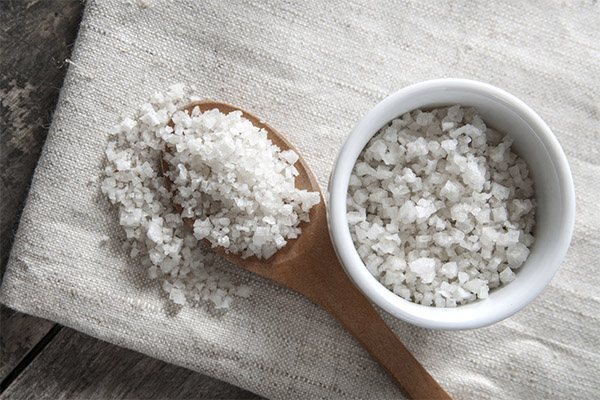
The product should be stored in a sealed container in a dry place. To prevent moisture from being absorbed, you can put a hygroscopic cloth or paper at the bottom of the container or pour rice, which will absorb excess water.
Interesting facts about sea salt
- From the diet of young children, particularly infants, it is necessary to completely eliminate salt. According to experts, the internal organs of babies, including the kidneys, are not yet fully adapted to some products, so they can not effectively process them.
- Salt can vary in color and taste depending on where it is extracted. Salt is of little value in its gray color.
- Salt prevents putrefaction processes, so it can be used as an antiseptic. This effect can be noticed if you spend a long time and often in salt water. In such cases, wounds on the body will heal much longer, while the substances in the sea salt will destroy any bacteria.
- Sea salt began to be extracted about 4,000 years ago. Ancient people filled shallow ponds with seawater and waited for the liquid to evaporate completely. When all the water had evaporated, they would calmly collect the salt that remained at the bottom.
- In ancient times, sea salt was used to make salted brandy. This drink has been used as a cure for sprains, sprains, spinal ailments, headaches and wounds.
- About 6 million tons of salt are mined worldwide each year.
«Important: All information on this site is provided for informational purposes only for information purposes only. Always seek advice from a health care professional before following any recommendation. specialist before applying any recommendations. Neither the editors nor the authors shall be liable for any possible harm caused by materials."

